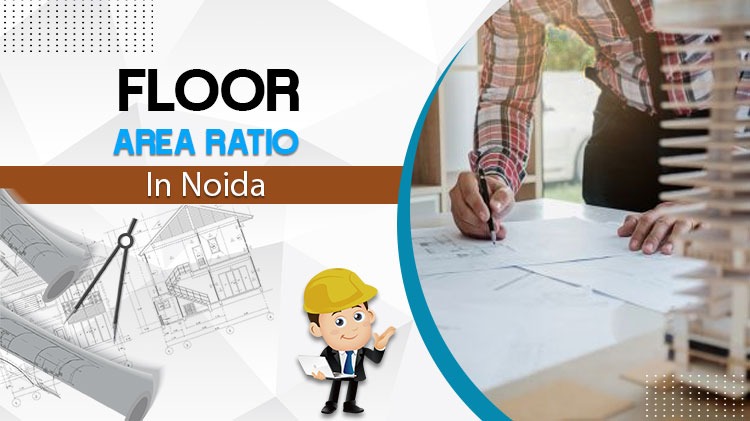Table of Contents
The total floor area of a structure that can be built on a particular piece of land is determined by the floor area ratio (FAR). The Noida Development Authority (NDA) oversees FAR in Noida. The zoning of the region, the type of development, and the size of the land all have an impact on the FAR limit.
The maximum FAR in Noida is 2.75 for residential units and 4.0 for commercial sites, per NDA regulations. The FAR cap may be greater for specific development types, such as companies or cooperative housing associations, as this regulation includes several exceptions.
It’s crucial to remember that in addition to the FAR, Noida developers must abide by extra rules. Setback requirements, building height restrictions, and parking restrictions are additional constraints. These rules are designed to conserve resources like water, power, and transportation while also ensuring that new development doesn’t have a negative influence on the city’s infrastructure and overall character.
How Does Floor Area Ratio Work?
The Floor space Ratio (FAR), a planning tool, establishes a limit on how much floor space can be developed on a specific piece of land. The Noida Construction Authority (NDA), which is in charge of FAR in Noida, uses it to limit the amount of construction that is permitted in a certain area.
FAR is derived by dividing a building’s total floor area across all levels by the lot size. For instance, a house with a total area of 1000 square metres and a FAR of 2.75 can have a maximum floor area of 2750 square metres.
The zoning of the region, the type of development, and the size of the land all have an impact on the FAR limit. The maximum FAR in Noida is typically 2.75 for residential plots and 4.0 for commercial projects. This law has a few exceptions, and the FAR maximum may be higher for particular undertakings, including cooperative housing societies or commercial ventures.
FAR is a significant tool for architects and urban planners because it ensures that the built environment is compatible with the resources and infrastructure that are already available. FAR can assist prevent overdevelopment and ensure that new projects are in line with the character and needs of the neighbourhood by limiting the amount of floor area that can be erected on a single parcel of land.
Importance Of Floor Area Ratio In Noida
In Noida, the Floor Area Ratio (FAR) is a crucial instrument for urban planning and development. It aids in limiting how much growth is allowed in a specific location and makes sure that brand-new buildings are compatible with the infrastructure and resources that are already there.
FAR is significant in Noida for a number of reasons, including:
● Effective use of land: By limiting the amount of floor area that can be constructed on a given plot, FAR guarantees that the land that is available is used as effectively as possible. This helps to prevent overdevelopment and ensures that new buildings are in accord with the aesthetic and functional requirements of the neighbourhood.
● Congestion control: By limiting the amount of floor area that may be constructed on a specific plot, FAR aids in the control of congestion and lessens the demand placed on infrastructure and resources like roads, water, and power.
● Environmental sustainability: By limiting the amount of development allowed in a specific area, FAR is a crucial instrument for fostering environmental sustainability. FAR can help to reduce the depletion of natural resources and lessen the environmental effect of new structures by limiting the amount of floor area that can be erected on a specific plot.
● Enhancing livability: FAR can contribute to improving the livability of a neighbourhood or community by limiting the amount of development that is permitted in a specific area. It can guarantee that new constructions are in line with the requirements and preferences of the local residents and workers.
Method for Calculating Floor Area Ratio
The Noida Development Authority’s (NDA) recommended formula to determine the Floor Area Ratio (FAR) in Noida. The following is the formula for determining FAR:
FAR is equal to the sum of the covered areas of the building’s floors divided by the plot’s total area.
The steps for calculating FAR in Noida are as follows:
Calculate the total covered area of the building’s floors: This comprises the entire area that the building’s floors, including the ground floor and any extra storeys, occupy. Measuring this space in square metres is appropriate.
● Calculate the plot’s overall size: This is the size of the whole property that the building is situated on. Measuring this space in square metres is appropriate.
Divide the entire covered area of the building’s storeys by the plot’s total area: You will receive the building’s FAR after doing this. The FAR has no units and is stated as a ratio.
● For instance, the FAR for a building would be as follows if the total covered area of all floors of a building is 5000 square metres and the entire plot area is 2000 square metres:
FAR = 5000 / 2000 = 2.5
The maximum FAR limit in Noida varies according on the area’s zoning, the kind of development, and the size of the property. It is crucial to confirm that the FAR for a certain structure is within the permitted ranges by consulting the Noida Development Authority’s rules.
Plot Floor Area Ratio in Noida
An important consideration in Noida real estate development is the plot floor area ratio (FAR). FAR, which is calculated as the ratio of the total covered area of all floors of a structure to the total size of the plot, is a measurement of the total floor area that may be built on a specific piece of land. The Noida Development Authority (NDA) establishes the FAR limit, which varies depending on the type of development, the size of the property, and the local zoning.
Along with the FAR, developers in Noida also have to abide by a number of additional rules, including setback standards, building height restrictions, and parking specifications. Setbacks are the minimum distances that a building must be from the plot’s edge or from nearby structures. Building height restrictions set a building’s maximum height, whereas parking specifications specify the number of parking spots that must be provided for the development.
All of these rules are intended to make sure that new construction in Noida blends in with the infrastructure and surroundings. By encouraging the responsible and effective use of resources like land, water, and energy, they want to find a balance between economic growth and sustainability. Developers can contribute to Noida’s long-term growth and success by abiding by these rules while also designing fresh, cutting-edge locations for people to live and work in.
Also Read: Difference Between Carpet Area, Built Up Area and Super Area
Conclusion
the Floor Area Ratio (FAR) is an important consideration in Noida real estate development. The Noida Development Authority (NDA) controls this measurement of the total floor space that may be built on a certain plot of land. The FAR limit varies based on a number of variables, including the type of development, the size of the site, and the local zoning.
Developers in Noida must additionally abide by additional rules such as setbacks, building height restrictions, and parking specifications. All of these rules aim to promote the responsible and effective use of resources, including land, water, and energy by ensuring that new developments blend in with the surrounding environment and infrastructure.
Developers can contribute to Noida’s long-term growth and success by abiding by these rules while also designing fresh, cutting-edge locations for people to live and work in. For this reason, Noida real estate developers and investors must comprehend the FAR and other restrictions.
FAQs
1. In Noida, what is FAR?
Floor Area Ratio, or FAR for short, is a measurement of the total floor area that can be built on a specific plot of land in Noida.
2. Who oversees Noida’s FAR?
The Noida Development Authority (NDA) in Noida regulates FAR.
3. In Noida, what is the highest FAR allowed for residential plots?
According to NDA regulations, the maximum FAR for residential sites in Noida is 2.75.
4. In Noida, what is the highest FAR allowed for commercial plots?
According to NDA norms, the maximum FAR for commercial sites in Noida is 4.0.
5. Can the Noida FAR limit be exceeded?
In Noida, there are various exceptions to the FAR restriction, and for particular types of construction, like group housing societies or commercial projects, the FAR limit may be higher.
6. How is Noida’s FAR determined?
FAR is determined by dividing the total covered area of a building’s storeys by the plot’s total area.
7. What do Noida setbacks entail?
Setbacks in Noida relate to the minimal separation required between a building and the plot’s boundary or nearby structures.
8. In Noida, what are the maximum building heights?
The maximum height of a building in Noida is constrained by building height restrictions.
9. What are Noida’s parking regulations?
The amount of parking spots that must be provided for the development must meet Noida parking regulations.
10. What makes FAR significant in Noida?
FAR is crucial in Noida because it makes sure that new construction complements the existing nature and infrastructure of the city and does not place an undue burden on its supply of water, power, and transportation.
11. In Noida, what are the consequences of breaking the FAR rules?
The Noida Development Authority may impose fines, impose penalties, or take legal action if FAR rules are broken there.
12. How do I find out the FAR for a specific site in Noida?
Consult the Noida Development Authority’s guidelines or get in touch with a certified real estate professional (country roof) to find out the FAR for a specific land in Noida.
13. Is it possible to request a higher FAR limit in Noida?
If your development fits into one of the categories that permits a higher FAR limit, you may apply for one in Noida.
14. How does FAR affect Noida real estate costs?
The maximum amount of development that may be done on a specific plot of land is determined by FAR, which has an effect on Noida’s property values.
15. How do real estate developers in Noida contribute to the FAR regulations?
To make sure that their developments are sustainable, in harmony with the local environment and infrastructure, and contribute to the long-term development and prosperity of the city, real estate developers in Noida must abide by FAR and other rules.




